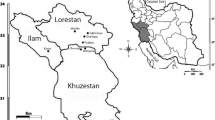Abstract
Melissa officinalis is an important medicinal plant and is extensively used by locals. This species is growing in different regions of Iran and forms several local populations. There is no information on population genetics or genetic variability of this species from Iran based on SCoT marker. Therefore, we carried out population genetic study of this plant species by analyzing 10 geographical populations. The analysis molecular variance test produced significant genetic difference among the studied populations. Neighbor Joining tree and Principal Coordinates Analysis plot produced similar results. They grouped plants of each population almost in a separate cluster, but also revealed a higher degree of within population genetic variability in many populations. The Mantel test produced significant correlation between genetic distance and geographical distance of the studied populations and the occurrence of isolation by distance in M. officinalis. Discriminating power of the start codon targeted (ScoT) marker analysis identified some ScoT loci with adaptive potentials. This study indicated that a combination of population genetic divergence, genetic drift, limited amount of gene flow and adaptation are acting together in M. officinalis populations. Such data can be used in conservation of this important plant in the country.

Similar content being viewed by others
Availability of data and material
The data that support the findings of this study are available on request from the corresponding author. The data are not publicly available due to privacy or ethical restrictions.
References
Bagdat RB, Cosge B (2006) The essential oil of Lemon balm (Melissa officinalis L.), its components and using fields. J Fac Agric Kyushu Univ 21:116–121
Chen XY (2000) Effects of fragmentation on genetic structure of plant populations and implications for the biodiversity conservation. Acta Ecol Sinica 20:884–892
Collard BCY, Mackill DJ (2009) Start codon targeted (SCoT) polymorphism: a simple, novel DNA marker technique for generating gene-targeted markers in plants. Plant Mol Biol Report 27:86–93
Ellis JR, Burke JM (2007) EST-SSRs as a resource for population genetic analyses. Heredity 99:125–132
Falush D, Stephens M, Pritchard JK (2007) Inference of population structure using multi locus genotype data: dominant markers and null alleles. Mol Ecol Notes 7:574–578
Freeland JR, Kirk H, Peterson SD (2011) Molecular Ecology, second ed. Wiley-Blackwell, UK
Heidari P, Mehrabi AA, Nasrolah nezhad ghomi AA (2013) Cytogenetic diversity of Iranian balm (Melissa officinalis) landraces and genetic relationship within and between them using ITS markers. Biharean Biol 7(2):94–98
Hou Y, Lou A (2011) Population Genetic Diversity and Structure of a Naturally Isolated Plant Species, Rhodiola dumulosa (Crassulaceae). PLoS ONE 6:e24497
Huson DH, Bryant D (2006) Application of phylogenetic networks in evolutionary studies. Mol Bio Evol. 23:254–267
Hutchison DW, Templeton AR (1999) Correlation of pairwise genetic and geographic distance measures: inferring the relative influences of gene flow and drift on the distribution of genetic variability. Evolution 53:1898–1914
Luo C, He XH, Chen H, Ou SJ, Gao MP, Brown JS, Tondo CT, Schnell RJ (2011) Genetic diversity of mango cultivars estimated using SCoT and ISSR markers. Biochem Syst Ecol 39:676–684
Medrano M, Herrera CM (2008) Geographical structuring of genetic diversity across the whole distribution range of Narcissus longispathus, a habitat-specialist. Mediterranean Narrow Endemic Ann Bot 102:183–194
Miraj S, Rafiean Kopae M, Kiani S (2017) Melissa officinalis L: a review study with an antioxidant prospective. Evid Based Complement Alternat Med 22(3):385–394
Mohebi Anabat M, Riahi H, Sheidai M, Koohdar F (2020) Population genetic study and barcoding in Iran saffron (Crocus sativus L.). Ind Crop Prod 143:111915
Øm H, Harper DAT, Ryan PD (2012) PAST: Paleontological Statistics software package for education and data analysis. Palaeontol Elect 4:9
Peakall R, Smouse PE (2006) GENALEX 6: genetic analysis in excel. population genetic software for teaching and research. Mol Ecol Notes 6:288–295
Podani J (2000). Introduction to the Exploration of Multivariate Data [English translation].
Rahimi M, Kordrostami M (2017) Genetic diversity evaluation of lemon balm (Melissa officinalis L.) ecotypes using morphological traits and molecular markers. JMPB 1:97–104
Richards CM (2000) Inbreeding depression and genetic rescue in a plant meta population. Am Nat 155:383–394
Saboori S, Noormohammadi Z, Sheidai M, Marashi SM (2019) SCoT molecular markers and genetic fingerprinting of date palm (Phoenix dactylifera L.) cultivars. Genet Resour Crop Evol. 67(1):73–82
Setsuko S, Ishida K, Ueno S, Tsu mura Y, Tomaru N, (2007) Population differentiation AND gene flow within a meta population of a threatened tree, Magnolia stellata (Magnoliaceae). Am Bot 94:128–136
Sheidai M, Seif E, Nouroozi M, Noormohammadi Z (2012) Cytogenetic and molecular diversity of Cirsium arvense (Asteraceae) populations in Iran. J Jap Bot 87:193–205
Sheidai M, Afshar F, Keshavarzi M, Talebi SM, Noormohammadi Z, Shafaf T (2014) Genetic diversity and genome size variability in Linum austriacum (Linaceae) populations. Biochem Syst Ecol 57:20–26
Slatkin M (1993) Isolation by distance in equilibrium and non-equilibrium populations. Evolution 47:264–279
Weising K, Nybom H, Wolff K, Kahl G (2005) DNA Fingerprinting in Plants. In: Principles, Methods, and Applications. 2nd ed, Boca Rayton Fl, CRC Press, USA, 472 pp.
Yuan Zh, Yin Y, Qu J, Zhu L, Li Y (2007) Population genetic diversity in Chinese pomegranate (Punica granatum L.) cultivars revealed by fluorescent-AFLP markers. J Genet Genomics. 34(12):1061–1071
Author information
Authors and Affiliations
Corresponding author
Ethics declarations
Conflict of interest
The authors declare that they have no conflict of interest.
Additional information
Publisher's Note
Springer Nature remains neutral with regard to jurisdictional claims in published maps and institutional affiliations.
Rights and permissions
About this article
Cite this article
Koohdar, F., Sheidai, M. Genetic diversity and population structure in medicinal plant Melissa officinalis L. (Lamiaceae). Genet Resour Crop Evol 69, 1753–1758 (2022). https://doi.org/10.1007/s10722-021-01338-7
Received:
Accepted:
Published:
Issue Date:
DOI: https://doi.org/10.1007/s10722-021-01338-7




